Read Exodus 20:22-26 at Bible Gateway.
Hebrew paragraph division
Exo 20:22-26 {p} Explanation of first three commandments
Exo 20:22-26 {p} chiastic structure 1
A pair: What you have seen (1A) and what you must not allow to be seen (2A).
B pair: gods of silver and gold are made by man lifting up his tool on the silver and gold (1B); so also if man lifts up his tool on the stones of YHVH’s altar, he profanes it (2B).
D pair: To sacrifice here is Strong’s H2076, zabach, a sacrifice offered by a private person. But we learn further along in Torah, that the purpose of bringing an offering from the sheep or from the goats, is to draw near to God. So the man brings a sacrifice to draw near to God (1D) and when he does so, God in turn comes to him (2D), i.e., he draws near to him. The burnt offering and peace offering are offerings brought to worship God, and not to atone for sin. In other words, the man brings them to bless God (1D) and in turn God blesses him (2D).
Exo 20:22-26 {p} chiastic structure 2
B.2 pair: We saw yesterday that to slaughter, zabach, the word rendered “sacrifice” here, is that which the man lifts up his tool or knife (zayin) upon outside the wall of his home. So the man lifts up his tool upon the sheep or the oxen to bless God (1B.2) but does not lift up his tool upon the stone of the altar so that he does not profane that which is set apart to God (2B.2)
B.3 pair: We saw yesterday that the burnt offering, olah, was from the primitive root meaning, “to ascend,” as the smoke ascends up from the whole burnt offering. In fact, in Strong’s the complete definition for the olah reads:
a step or (collectively, stairs, as ascending); usually a holocaust (as going up in smoke):—ascent, burnt offering (sacrifice), go up to.
So the smoke of the burnt offering ascends up as steps ascending up (1B.3) but the man is not to ascend up by steps (2B.3).
Exo 20:22-26 {p} chiastic structure 3
This structure brings out the same pairings as the first and second structures, especially the reciprocal nature of the burnt offering, the olah, and the peace offering, the shelem; that we draw near to God and He draws near to us, and we give thanks to God and He returns blessing to us.
The structures shine a spotlight on the reciprocal nature of our relationship with God as we worship Him according to His commandments, commandments 1-3; He alone is God therefore we make no gods of silver or gold to be with Him; and where we remember His name, He will bless us, but we bring our offerings so that we do not profane His altar; ultimately, so that we do not profane His name.




















Leave a Reply